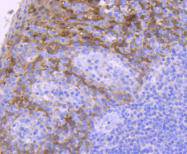Product Detail
Product Name14-3-3 sigma Rabbit mAb
Clone No.SD2070
Host SpeciesRecombinant Rabbit
Clonality Monoclonal
PurificationProA affinity purified
ApplicationsWB, IHC
Species ReactivityHu, Rt
Immunogen Descrecombinant protein
ConjugateUnconjugated
Other Names14 3 3 protein sigma antibody 14-3-3 protein sigma antibody 1433S_HUMAN antibody Epithelial cell marker protein 1 antibody Er antibody HME 1 antibody HME1 antibody MGC143283 antibody Mkrn3 antibody Mme1 antibody OTTHUMP00000004242 antibody RP23 137L22.11 antibody SFN antibody SFN protein antibody Stratifin antibody YWHAS antibody
Accession NoSwiss-Prot#:P31947
Uniprot
P31947
Gene ID
2810;
Calculated MW28 kDa
Formulation1*TBS (pH7.4), 1%BSA, 40%Glycerol. Preservative: 0.05% Sodium Azide.
StorageStore at -20˚C
Application Details
WB: 1:1,000
IHC: 1:50-1:200
Immunohistochemical analysis of paraffin-embedded human tonsil tissue using anti-14-3-3 sigma antibody. Counter stained with hematoxylin.
Immunohistochemical analysis of paraffin-embedded human breast carcinoma tissue using anti-14-3-3 sigma antibody. Counter stained with hematoxylin.
14-3-3 proteins regulate many cellular processes relevant to cancer biology, notably apoptosis, mitogenic signaling and cell-cycle checkpoints. Seven isoforms, denoted 14-3-3 b, g, e, z, h, q and s, comprise this family of signaling intermediates. 14-3-3 s, also known as SFN, stratifin, HME1 or YWHAS, is a secreted adaptor protein that is involved in regulating both general and specific signaling pathways. Expressed predominately in stratified squamous keratinising epithelium, 14-3-3 s is able to bind and modify the activity of a large number of proteins, such as KRT17 (Keratin 17), through recognition of a phosphothreonine or phosphoserine motif. When bound to Keratin 17, for example, 14-3-3 s acts to stimulate the Akt/mTOR signaling pathway by upregulating protein synthesis and cell growth. 14-3-3 s also functions to positively mediate IGF-I-induced cell cycle progression and can bind to a variety of translation initiation factors, thus controlling mitotic translation. In response to tumor growth, 14-3-3 s positively regulates the tumor suppressor p53 and increases the rate of p53-regulated inhibition of G2/M cell cycle progression. Multiple isoforms of 14-3-3 s exist due to alternative splicing events.
If you have published an article using product 49152, please notify us so that we can cite your literature.




 Yes
Yes



